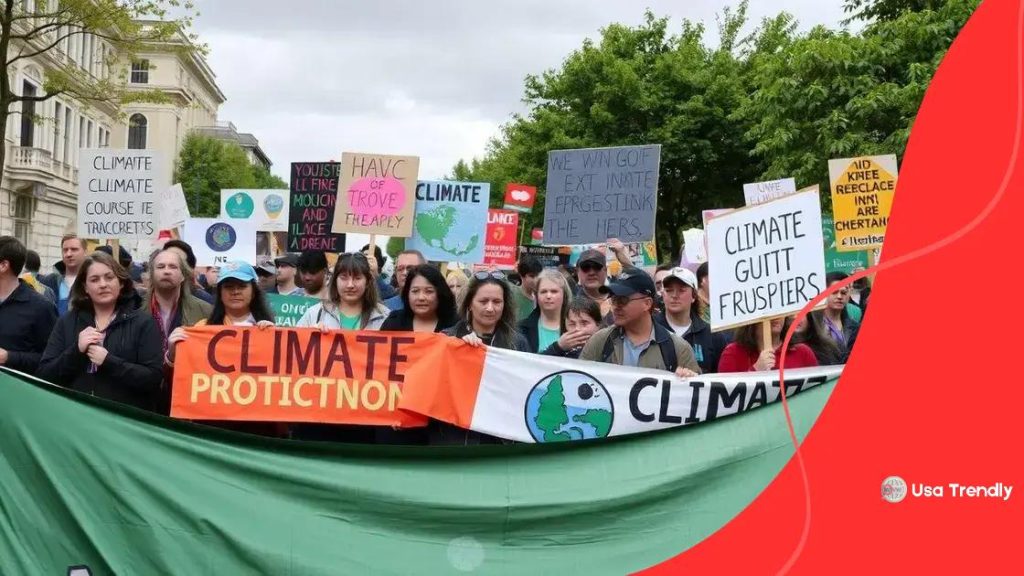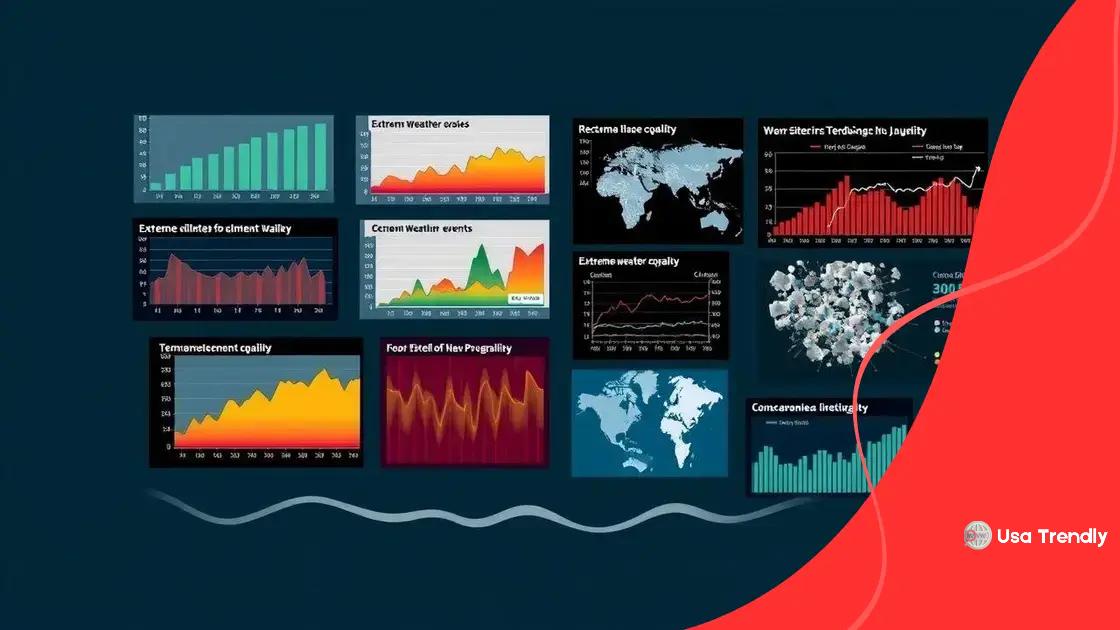Environmental groups alarmed by climate reversals

Environmental groups alarmed by climate reversals highlight the urgent need for collective action and sustainable solutions to combat climate change effectively.
Environmental groups alarmed by climate reversals are raising their voices, urging us to consider the consequences of our actions on the planet. How serious are these reversals, and what can we do about them? Let’s explore this pressing issue together.
Understanding climate reversals and their implications
Understanding climate reversals is crucial for grasping the current environmental challenges we face. These reversals, which indicate a shift in the climate’s stability, can lead to severe consequences for ecosystems and human health.
What Are Climate Reversals?
Simply put, climate reversals refer to significant changes in the Earth’s climate patterns that can disrupt the normal functioning of our planet. They can occur due to various factors, including natural processes and human activities. Examples include sudden temperature drops or unexpected weather patterns.
Implications of Climate Reversals
The implications of such reversals are far-reaching and can be alarming. For instance, they may:
- Disrupt natural ecosystems: Alterations in climate can impact habitats, leading to species extinction.
- Threaten food security: Changes in growing seasons can affect crop yields.
- Increase health risks: Extreme weather can contribute to diseases and respiratory issues.
- Cause economic strain: The cost of adapting to these changes can burden communities.
Additionally, we must acknowledge that climate reversals are often interlinked with human activities. Deforestation, pollution, and carbon emissions significantly contribute to these shifts. Thus, our actions play a pivotal role in either exacerbating or alleviating the problem.
Addressing the causes of climate reversals requires a collective effort. It’s essential for communities, governments, and individuals to work together to develop sustainable solutions. This can include transitioning to renewable energy, promoting reforestation, and supporting policies aimed at reducing emissions.
Ultimately, understanding climate reversals helps us to react effectively. By recognizing their implications, we can advocate for better practices that protect our environment for future generations.
The role of environmental groups in addressing climate change
The role of environmental groups in addressing climate change is vital. These organizations work tirelessly to raise awareness, advocate for policy changes, and mobilize the public to take action.
Advocacy and Policy Changes
Many environmental groups focus on advocating for stronger environmental policies. They collaborate with lawmakers to push for legislation that targets climate change mitigation. Through lobbying efforts, these groups aim to create comprehensive regulations that limit carbon emissions.
Public Education and Awareness
Education is another critical area where environmental groups excel. By providing valuable information to the public, they empower individuals to make informed decisions. These groups often host workshops, produce informative materials, and utilize social media to spread their message.
- Campaigns: They launch campaigns to raise awareness about key environmental issues.
- Workshops: Educational workshops teach sustainable practices to communities.
- Community Involvement: Encouraging community participation in environmental initiatives.
Furthermore, environmental groups often engage in grassroots movements that unite communities around a common cause. This collaboration can lead to local initiatives that directly combat climate issues. For instance, local clean-up events and tree-planting projects not only improve environmental health but also foster community spirit.
Collaboration with scientists is also crucial. By working with researchers, environmental groups can leverage scientific data to support their initiatives. This partnership enhances their credibility and helps them present compelling arguments to decision-makers.
The impact of these groups is evident in various victories against climate change. From securing protected areas to enforcing stricter pollution controls, their efforts contribute significantly to safeguarding our planet.
Recent alarming trends in climate data

Recent alarming trends in climate data have raised significant concerns among scientists and environmentalists. As we analyze the latest information, it becomes clear that the impacts of climate change are becoming more severe.
Temperature Increases
One major trend is the rise in average global temperatures. Over the past few decades, we’ve seen a steady increase, with 2020 being one of the hottest years on record. This rise leads to a range of issues, including melting glaciers and rising sea levels, which threaten coastal communities.
Extreme Weather Events
Another alarming trend is the increase in extreme weather events. From devastating hurricanes to record-breaking heatwaves, these events are becoming more frequent and intense. They disrupt ecosystems and pose risks to human health and safety.
- Hurricanes: More powerful storms are causing widespread destruction.
- Droughts: Extended dry periods are crippling agriculture.
- Floods: Increased rainfall leads to severe flooding in various regions.
Furthermore, the data indicates a concerning trend in ocean temperatures. Rising sea temperatures contribute to coral bleaching and affect marine life. As marine ecosystems struggle, the ripple effects impact food security for millions who rely on fisheries.
Carbon dioxide levels in the atmosphere have also reached unprecedented highs. This increase correlates with human activities such as burning fossil fuels and deforestation. As carbon traps heat, it compounds the effects of climate change, making it essential to address our emissions.
In conclusion, monitoring recent alarming trends in climate data is critical for understanding our planet’s health. By recognizing these patterns, we can better inform policies and advocate for necessary action.
Strategies proposed by activists and scientists
Strategies proposed by activists and scientists play a crucial role in combating climate change. These strategies focus on mitigating its effects and promoting sustainable practices across various sectors.
Reducing Carbon Emissions
One of the primary strategies is to reduce carbon emissions. This can be achieved by transitioning to renewable energy sources such as solar, wind, and hydro power. By replacing fossil fuels with cleaner alternatives, we can significantly lower greenhouse gas emissions.
Enhancing Energy Efficiency
Improving energy efficiency is another effective approach. Small changes, like using LED light bulbs and Energy Star appliances, can lead to substantial reductions in energy consumption. Additionally, building retrofits and well-designed public transport systems help minimize energy use.
- Switching to electric vehicles: Electric cars produce no tailpipe emissions.
- Promoting public transport: Efficient public transport systems reduce the number of cars on the road.
- Encouraging cycling and walking: Creating bike lanes and safe pedestrian pathways promotes eco-friendly commuting.
Furthermore, scientists emphasize the importance of investing in carbon capture technology. This innovative method involves capturing carbon dioxide emissions from industrial processes and storing it underground, effectively reducing the amount of greenhouse gases in the atmosphere.
Another key strategy proposed is reforestation. Planting trees helps absorb carbon dioxide and restore natural ecosystems. Activists encourage community involvement in reforestation projects, which not only help the environment but also foster a sense of community.
Support for climate-friendly policies is essential. Activists often push for policies that align with sustainability goals, such as incentivizing clean energy developments and enforcing stricter regulations on emissions. These policies can lead to systemic changes that facilitate a greener future.
The importance of collective action for climate solutions
The importance of collective action for climate solutions cannot be overstated. When individuals, communities, and organizations come together, they can create a powerful force for environmental change.
Unity in Purpose
Collective action fosters unity in purpose, inspiring people to work toward common goals. Whether it’s advocating for policy changes or participating in local clean-up events, working together amplifies our impact. When more voices join in, the message becomes clearer and more compelling to decision-makers.
Grassroots Movements
Many successful climate initiatives begin at the grassroots level. Local groups often organize campaigns to address specific environmental issues. These grassroots movements mobilize community members to take action, such as:
- Tree planting drives: These initiatives help restore ecosystems and absorb carbon dioxide.
- Energy-saving challenges: Communities can compete to reduce energy consumption, fostering a culture of sustainability.
- Awareness campaigns: Raising awareness about local environmental challenges encourages community participation.
Moreover, collective action creates a sense of accountability. When individuals commit to making sustainable choices together, they encourage each other to follow through. This shared responsibility can lead to more lasting behavior changes.
Partnerships between various stakeholders also enhance efficacy. Collaborations among non-profits, businesses, and governments allow for resource sharing and expertise exchange. These partnerships can lead to innovative solutions and greater overall impact.
In addition, global initiatives like climate strikes and international agreements highlight the power of collective action on a larger scale. When movements gain momentum globally, they signal to policymakers that climate action is not just a local concern but a worldwide imperative.
FAQ – Frequently Asked Questions about Climate Action
What is collective action in addressing climate change?
Collective action involves individuals and groups working together to promote sustainability and combat climate change, amplifying their impact.
How can I reduce my carbon footprint?
You can reduce your carbon footprint by using renewable energy sources, driving less, and adopting energy-efficient practices at home.
Why is community involvement important for climate solutions?
Community involvement fosters unity and accountability, encouraging local actions like tree planting and recycling that contribute to environmental health.
What role do policies play in fighting climate change?
Policymaking is essential as it can enforce regulations that promote sustainable practices, limit emissions, and support initiatives to protect the environment.
SEE MORE CONTENT